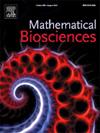在随机流行病模型中研究季节性疾病的出现和灭绝。
IF 1.9
4区 数学
Q2 BIOLOGY
引用次数: 0
摘要
季节性疾病爆发在许多传染病中都很常见,如季节性流感、寨卡病毒、登革热、莱姆病、疟疾和霍乱。季节性疾病爆发通常是由于天气模式影响了病原体或携带疾病的病媒,或者是由于社会行为造成的。我们研究了季节性随机流行病模型中疾病的出现和消亡。具体来说,我们研究的是在时间非均质马尔可夫链中,通过季节性变化的传播、恢复、病媒出生和死亡参数,在 SIR、SEIR 和病媒-宿主系统中出现疾病。马尔可夫链的分支过程近似用于估计疾病灭绝的季节概率。使用几种疾病结果测量方法来比较季节性环境和恒定环境下的动态变化。数值研究说明并证实了之前从随机流行病模型中得出的结果。与恒定环境相比,季节性环境通常导致较低的疾病出现概率和较小的基本繁殖数值,而且疾病出现的高峰时间通常早于季节性驱动因素的高峰时间。当传播和恢复都随季节变化时,我们发现了一些新的结果。如果恢复的相对幅度超过传播的相对幅度,或者周期在时间上不同步,那么在恒定环境中出现疾病的平均概率要低于季节性环境。我们还调查了病媒控制的时机。这项调查为研究季节性传染病的动态提供了新的方法和结果衡量标准,并为预防和控制的时机提供了新的见解。本文章由计算机程序翻译,如有差异,请以英文原文为准。
Investigating seasonal disease emergence and extinction in stochastic epidemic models
Seasonal disease outbreaks are common in many infectious diseases such as seasonal influenza, Zika, dengue fever, Lyme disease, malaria, and cholera. Seasonal outbreaks are often due to weather patterns affecting pathogens or disease-carrying vectors or by social behavior. We investigate disease emergence and extinction in seasonal stochastic epidemic models. Specifically, we study disease emergence through seasonally varying parameters for transmission, recovery, and vector births and deaths in time-nonhomogeneous Markov chains for SIR, SEIR, and vector-host systems. A branching process approximation of the Markov chain is used to estimate the seasonal probabilities of disease extinction. Several disease outcome measures are used to compare the dynamics in seasonal and constant environments. Numerical investigations illustrate and confirm previous results derived from stochastic epidemic models. Seasonal environments often result in lower probabilities of disease emergence and smaller values of the basic reproduction number than in constant environments, and the time of peak emergence generally precedes the peak time of the seasonal driver. We identify some new results when both transmission and recovery vary seasonally. If the relative amplitude of the recovery exceeds that of transmission or if the periodicity is not synchronized in time, lower average probabilities of disease emergence occur in a constant environment than in a seasonal environment. We also investigate the timing of vector control. This investigation provides new methods and outcome measures to study seasonal infectious disease dynamics and offers new insights into the timing of prevention and control.
求助全文
通过发布文献求助,成功后即可免费获取论文全文。
去求助
来源期刊

Mathematical Biosciences
生物-生物学
CiteScore
7.50
自引率
2.30%
发文量
67
审稿时长
18 days
期刊介绍:
Mathematical Biosciences publishes work providing new concepts or new understanding of biological systems using mathematical models, or methodological articles likely to find application to multiple biological systems. Papers are expected to present a major research finding of broad significance for the biological sciences, or mathematical biology. Mathematical Biosciences welcomes original research articles, letters, reviews and perspectives.
 求助内容:
求助内容: 应助结果提醒方式:
应助结果提醒方式:


